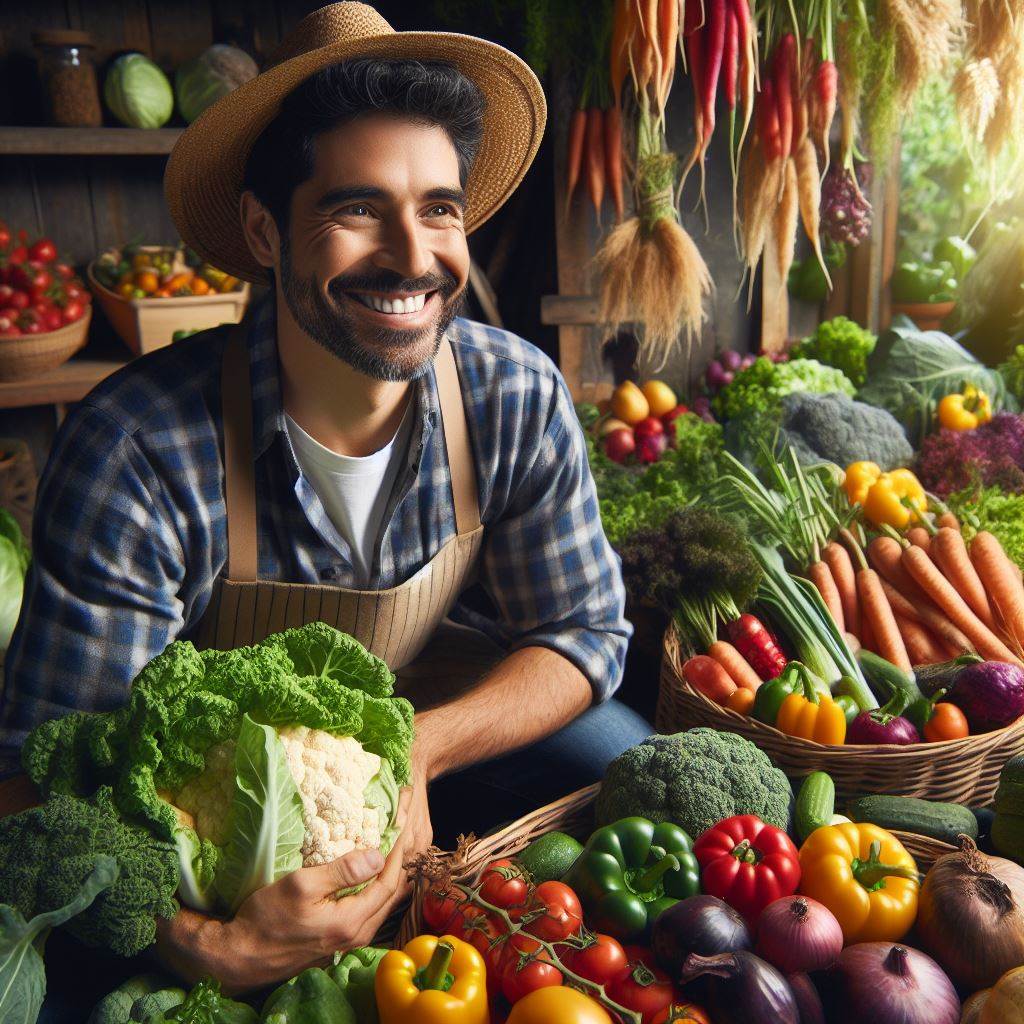Introduction
Brief explanation of urban farming
Urban farming has gained popularity in recent years as a viable solution to address food security and sustainability challenges in cities.
With the world’s population continuously rising, urban areas face the need to produce adequate food for their inhabitants.
Urban farming offers a unique approach to tackle this issue by utilizing unconventional spaces such as rooftops, vacant lots, and even walls, to grow a variety of crops.
Importance and relevance of growing food in cities
The importance and relevance of growing food in cities cannot be overstated.
Firstly, urban farming helps mitigate the limited availability of agricultural land.
As urbanization expands, traditional farmlands are converted into commercial, residential, or industrial zones.
By utilizing urban spaces, cities can offset the reduction in available farmland, ensuring a steady supply of fresh produce.
Moreover, urban farming promotes food security.
By cultivating food locally, cities become less reliant on long-distance transportation and global food markets.
This reduces the vulnerability of urban populations to supply chain disruptions or price fluctuations, ensuring a more stable and affordable food supply.
Furthermore, urban farming offers environmental benefits.
By growing food in cities, carbon emissions associated with long-distance transportation are significantly reduced.
Additionally, urban farming systems can incorporate sustainable practices like composting and rainwater harvesting, minimizing waste and conserving resources.
Basically, urban farming is a promising solution that can address the challenges of food security, sustainability, and limited agricultural land in cities.
Its importance and relevance lie in its ability to provide a local, resilient, and environmentally friendly food production system.
Transform Your Agribusiness
Unlock your farm's potential with expert advice tailored to your needs. Get actionable steps that drive real results.
Get StartedBenefits of Urban Farming
Increased access to fresh and nutritious food
Urban farming allows communities to have easy access to fresh and healthy produce.
By growing food in cities, people can have immediate access to nutritious fruits and vegetables.
Urban farms eliminate the need for long transportation processes, ensuring that the food is always fresh.
Reduction of food miles and carbon footprint
Urban farming significantly reduces the distance food travels from the farm to the consumer.
By decreasing food miles, urban farming reduces carbon emissions from transportation.
This environmentally-friendly approach helps mitigate climate change and promotes sustainable living.
Improving food security in urban areas
Urban farming plays a vital role in enhancing food security, especially in densely populated urban areas.
By producing food locally, cities can rely less on external food sources during times of crisis.
This self-sufficiency helps ensure a stable and secure food supply for urban communities.
Social and community benefits
Urban farming brings people together, fostering a sense of community and connection.
Community gardens and urban farms provide a space for neighbors to interact and collaborate.
These spaces often become hubs of learning, where people share knowledge and skills related to farming.
Utilization of unused or underutilized urban spaces
Urban farming creatively transforms vacant lots, rooftops, and unused urban spaces into productive land.
By utilizing underutilized spaces, urban farming optimizes land efficiency and reduces urban blight.
This revitalization improves the aesthetic appeal of neighborhoods and promotes a greener urban landscape.
Essentially, urban farming offers numerous benefits that positively impact both individuals and communities alike.
It provides increased access to fresh and nutritious food, reduces food miles and carbon footprint, improves food security, and fosters social and community connections.
Moreover, it creatively uses unused urban spaces, revitalizing neighborhoods and promoting a greener urban environment.
By embracing urban farming, cities can create a sustainable and resilient future, ensuring a healthier and more prosperous society.
Read: Seasonal Eats: Summer’s Best Recipes
Types of Urban Farming
Rooftop gardens
- Rooftop gardens are becoming increasingly popular in cities as a way to utilize unused space.
- These gardens are often created on top of buildings, utilizing the available sunlight and rainwater.
- They can be designed as simple vegetable gardens or more complex green spaces with trees and flowers.
Community gardens
- Community gardens are shared spaces where individuals or groups can grow their own food.
- These gardens are usually located on public or private land, allowing people to come together and work collaboratively.
- They promote community engagement, social interaction, and the sharing of knowledge and resources.
Vertical farming
- Vertical farming is a method of growing plants vertically, in stacked layers or on vertical surfaces.
- It maximizes limited space in urban areas by utilizing advanced technologies such as hydroponics or aeroponics.
- This innovative approach allows for year-round production and can be implemented in buildings or dedicated vertical farms.
Aquaponics and hydroponics
- Aquaponics and hydroponics are soil-less farming techniques that use water to cultivate plants.
- Aquaponics combines fish farming and hydroponics, where the fish waste provides nutrients for the plants.
- Hydroponics, on the other hand, directly supplies nutrient-rich water to the plants.
Urban agriculture on vacant lots
- Urban agriculture on vacant lots involves utilizing abandoned or underutilized spaces for farming purposes.
- These lots are often transformed into urban farms or gardens, providing fresh produce for local communities.
- This type of urban farming helps beautify neighborhoods, reduce food deserts, and create job opportunities.
While these are just a few examples, the diverse methods of urban farming are continuously evolving.
Each type of urban farming offers unique benefits and can be tailored to fit the specific needs and constraints of different cities.
With the growing interest in sustainable food production, urban farming is proving to be a viable solution for increasing food security and promoting a greener, healthier urban environment.
Read: 10 Easy Farm-Fresh Recipes You’ll Love
Showcase Your Farming Business
Publish your professional farming services profile on our blog for a one-time fee of $200 and reach a dedicated audience of farmers and agribusiness owners.
Publish Your ProfileOvercoming Challenges in Urban Farming
Limited space and land availability
- Urban farming faces challenges due to limited space and availability of land.
- Innovative solutions like vertical farming and rooftop gardens can maximize space utilization.
- Community gardens and shared spaces can be created to promote urban farming.
- Utilizing unused spaces like abandoned lots or parking lots can help overcome space constraints.
Access to affordable resources and funding
- Urban farmers often struggle to afford resources like seeds, fertilizers, and equipment.
- Government grants and subsidies can provide financial assistance for urban farming initiatives.
- Collaboration with local businesses or organizations can lead to resource sharing and cost reduction.
- Crowdfunding campaigns and sponsorships can help raise funds for urban farming projects.
Soil contamination and remediation
- Urban areas often suffer from soil contamination due to pollution and previous land use.
- Testing soil for contaminants and implementing remediation techniques is essential for safe food production.
- Composting and using organic amendments can improve soil quality and reduce contamination risks.
- Collaboration with environmental agencies and experts can provide guidance on soil remediation methods.
Local regulations and zoning restrictions
- Many cities have strict regulations and zoning restrictions that can limit urban farming activities.
- Advocacy and lobbying efforts can influence policymakers to create more favorable regulations.
- Collaboration with local governments to revise zoning codes and create urban farming-friendly policies.
- Building relationships with local officials and educating them about the benefits of urban farming.
Engaging and educating the community
- Community engagement is crucial for the success of urban farming initiatives.
- Organizing workshops, seminars, and educational programs to raise awareness about urban farming.
- Involving schools and community centers to educate children and adults about the importance of growing food locally.
- Creating volunteer opportunities and community involvement in urban farming projects to foster a sense of ownership and pride.
Overcoming challenges in urban farming requires innovative solutions, collaboration, and community engagement.
By addressing limitations in space, funding, soil quality, regulations, and community involvement, urban farming can flourish, providing fresh and sustainable food for cities.
Read: Farm-to-Table Basics: A Starter Guide

You Might Also Like: Local Food Trends in U.S. Urban Centers
Successful Urban Farming Projects
Case study: The Brooklyn Grange in NYC
The Brooklyn Grange, located in New York City, is a prime example of a successful urban farming project.
It is the world’s largest rooftop soil farm, spanning over two acres.
The farm is located on top of a building and utilizes innovative farming techniques such as hydroponics and aquaponics.
These methods allow for the efficient use of space and resources.
The Brooklyn Grange not only provides fresh and organic produce to the local community but also offers educational programs and workshops on sustainable farming practices.
By incorporating urban farming into the city landscape,
The Brooklyn Grange promotes food security, reduces food miles, and fosters a stronger connection between people and their food sources.
Case study: The Urban Farming Institute in Boston
In Boston, the Urban Farming Institute has been making strides in promoting urban agriculture and creating sustainable food systems.
This non-profit organization operates several urban farms throughout the city.
The farms not only produce fresh and nutritious food but also serve as educational and training centers for aspiring urban farmers.
The Urban Farming Institute offers courses on urban agriculture, organic gardening, and entrepreneurial skills.
By empowering individuals with the knowledge and skills to grow their own food, the Urban Farming Institute contributes to the resilience and self-sufficiency of urban communities.
Through partnerships with local businesses and organizations, they have been able to expand their reach and impact, making urban farming a viable solution for addressing the challenges of food insecurity in cities.
Case study: The Growing Home in Chicago
The Growing Home, located in Chicago, is a project that combines urban farming with workforce development.
This organization focuses on providing job training and employment opportunities for individuals with barriers to employment.
Through their urban farms, they grow organic produce and operate a market that sells locally grown food.
The Growing Home’s program includes not only hands-on farming experience but also support services and job placement assistance.
By incorporating urban farming into their workforce development program,
The Growing Home not only addresses the issue of food access but also tackles unemployment and poverty in the community.
Through their holistic approach, they empower individuals with the skills and resources needed to secure stable employment and build a brighter future.
In general, these case studies demonstrate the success and impact of urban farming projects in various cities.
From rooftop farms to job training programs, urban farming not only provides fresh and nutritious food but also addresses social and environmental challenges.
By utilizing innovative farming techniques, offering educational opportunities, and fostering community engagement, urban farming projects can create stronger, more sustainable food systems in cities.
Read: Sustainable Eating: Farm-to-Fork Focus
Tips for Starting an Urban Farm
Starting an urban farm requires careful planning and research to ensure success.
Here are some tips:
Conducting thorough research and planning
- Research different farming methods suitable for urban environments.
- Learn about local regulations and permits required for urban farming.
- Develop a detailed business plan including budget, timeline, and marketing strategies.
- Consider attending workshops or courses on urban farming to gain knowledge and skills.
Identifying suitable spaces and securing land
- Look for available land spaces such as vacant lots, rooftops, or community gardens.
- Contact local authorities or landowners to inquire about land availability and leasing options.
- Consider the accessibility, sunlight exposure, and soil quality of potential farming locations.
- Ensure proper agreements or contracts are signed to secure the land for farming purposes.
Choosing appropriate crops and farming methods
- Assess the climate and microclimates of your city to determine suitable crop options.
- Consider growing high-demand crops that have the potential for greater profitability.
- Choose farming methods such as hydroponics, aquaponics, or vertical farming based on available resources.
- Focus on sustainability by using organic fertilizers, promoting biodiversity, and reducing water waste.
Collaborating with local community organizations
- Reach out to local gardening or farming groups to gather support and shared knowledge.
- Collaborate with community organizations to secure resources and volunteers for your farm.
- Host workshops or events to educate and engage the community in urban farming initiatives.
- Establish partnerships with restaurants, schools, or food banks to distribute your produce.
Marketing and selling urban farm products
- Create a brand identity for your urban farm and develop a strong online presence.
- Utilize social media platforms and websites to showcase your farm’s products and practices.
- Participate in local farmers markets, food festivals, or community events to reach potential customers.
- Offer CSAs (Community Supported Agriculture) or subscription boxes to ensure regular sales.
Starting an urban farm may seem challenging, but with proper planning, research, and community collaboration, it can thrive and contribute to a sustainable and food-secure future.
Conclusion
Recap of the benefits and potential of urban farming
Urban farming offers numerous benefits, such as increased access to fresh and healthy produce, reduced environmental impact, and a stronger sense of community.
By utilizing available space in cities, we can transform vacant lots and rooftops into thriving gardens.
This not only provides food security but also enhances air quality and reduces the urban heat island effect.
Encouragement for individuals and communities to embrace urban farming
It is crucial for individuals and communities to embrace urban farming as a sustainable solution to food production.
By taking a proactive role in growing our own food, we can empower ourselves to make healthier choices and reduce dependence on industrial agriculture.
Additionally, urban farming can foster a sense of pride and connection to our surroundings, promoting a greener and more self-sufficient lifestyle.
Call-to-action to support and promote urban farming initiatives
To fully realize the potential of urban farming, we must actively support and promote initiatives that promote its growth.
This includes advocating for policy changes that make urban farming more accessible and providing resources and funding to individuals and organizations interested in starting their own urban gardens.
By doing so, we can create a paradigm shift in how we approach food production and consumption, creating healthier, more sustainable cities for future generations.
Showcase Your Farming Business
Publish your professional farming services profile on our blog for a one-time fee of $200 and reach a dedicated audience of farmers and agribusiness owners.
Publish Your ProfileIn a nutshell, urban farming presents a promising solution to address food security, environmental sustainability, and community engagement in cities.
By embracing this practice, individuals and communities can reap various benefits while also playing a vital role in creating healthier and more resilient urban landscapes.
It is time to take action and support urban farming initiatives for a better future.




